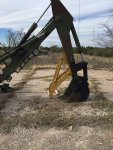Quonset hut construction continues, but let's face it, that's a cold, dark cave with a sketchy floor. So's the semi-derelict old garage I'm renting in town, I'll be using the SEE bucket to transport a pellet stove there from my shed here. Both FLUs will be getting entirely new air & fuel lines. Hydraulic lines actually can wait, prolly all that military paint mopped onto 'em, and we'll get to all the major/minor cylinder leaks come snowmelt.
Conceptually, those darn fuel lines are obsolete. They're all coming off both FLUs in favor of bog-standard, modern American stuff can be worked on at any truck stop without spending thousands of dollars for specialized tools & training to deal with 30-yr-old cutesy-tootsy proprietary Mercedes stuff. Hopefully the air lines are less of an issue? My two employees can handle that while I re-wire at least the battery primary cables.
I tend to get in over my head by continuing on and re-wiring the whole truck. In this case, just the primaries will suit me fine. Those milspec battery-post terminals are better used with the clamping bolt, rather than soldering in the cable. Both my FLUs, now that I've been hands-on with their batteries, have ultra-stiff and crackly short-cables between the batteries. Because those terminal clamps are simply too big to solder properly even with a propane torch -- even if you don't melt the insulation on that wire, you'll wick far too much solder up into the cable.
I couldn't close the battery box after swapping in the civvy batteries from my dead Dodge, not because that serial cable was the wrong length, but because it couldn't be flexed without breaking it. The solution was simple, several inches of 2AWG wire and a pair of temporary, clamp-type terminal clamps, for now. The batteries are in "T" formation, there's plenty of room in the box but the dimensions are all wrong regardless of how much wire you give yourself to work with between batteries. This is after removing the OEM battery tray & clamp, which need some cleaning up, rust removal, and re-painting before I put 6T batteries back in there, which could take a while...
The state of the primary battery wiring on both my FLUs is horrific due to improperly soldered cable termination. But that's a ridiculous soldering job to begin with! I solder my lugs onto my wire, then bolt 'em onto the milspec battery-terminal clamps, using silicone dielectric grease, and cover all that tin-plated copper up with rubber booties. Yeah, I shoulda taken pics of all the work I did on my dead Dodge before I scavenged its batteries for the SEE!
It isn't so much "there's a right way and a wrong way" to terminate battery cables, so much as I just can't fathom how the military decided soldering was preferable? I also don't know if these are original cables, or were part of the rebuilds at Red River? Either way, did they have proper equipment to heat up so much metal for soldering, or was it more they didn't have rosin-core flux available so they used acid-based flux meant for solid copper plumbing not stranded cable, and the stiff/brittle quality is more from corrosion over time than improper soldering leading to wicking?
If the vehicle is meant to be serviced in remote combat zones, let alone dropped out the back of a C-130, then it's even more unfathomable that the cable terminations are soldered into the clamps. If you terminate your cables with compression lugs, you can melt heavy-duty, adhesive-lined shrink tubing around it. Which you can't do if you solder cable directly into the terminal clamps! So that'll always be where your wire starts to corrode. Especially after 30 years, hard to say if all my FLU battery wires are this bad after 10 if they were rebuilt? Either way, maybe not wrong
per se, but totally wrong for my FLUs.
So, my first priority on both my FLUs, is a three-way tie between fuel lines, air lines, and battery cables. All just horrific on both Mogs.




